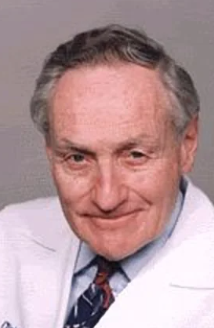An ongoing dialogue on HIV/AIDS, infectious diseases,
December 12th, 2024
Dr. Thomas O’Brien — Expert in Antimicrobial Resistance and Giant in His Field (Literally)
 Dr. Thomas (Tom) O’Brien was born in January 1929, in between the discovery of penicillin (September 1928) and the publication of the findings in a medical journal (May 1929). As noted by his longtime mentee Dr. John Stelling, Tom physically embodied the antibiotic era — quite appropriate for someone best known for his groundbreaking work in antimicrobial resistance. He died this week at the age of 95.
Dr. Thomas (Tom) O’Brien was born in January 1929, in between the discovery of penicillin (September 1928) and the publication of the findings in a medical journal (May 1929). As noted by his longtime mentee Dr. John Stelling, Tom physically embodied the antibiotic era — quite appropriate for someone best known for his groundbreaking work in antimicrobial resistance. He died this week at the age of 95.
A longtime faculty member here at Harvard Medical School and Brigham and Women’s Hospital, Tom inspired a crowd of people like me who knew him as a wonderful colleague and mentor. Regularly fielding questions about tricky drug-resistant bugs, he also radiated enthusiasm about the entire field of Infectious Diseases in a way that was never boastful or showy.
I can easily still picture his smiling face towering over the rest of us during weekly plate rounds in the microbiology laboratory, taking such pleasure in the minutiae of a surprising isolate or advance in diagnostics. “Look at this plate of VRE,” he once memorably said. “It grows better with vancomycin. How about that?”, followed by a quick chuckle of amazement at the smarts of microbes.
Tom also was the person whom I first heard describing the framework for thinking about patient care, leading to the The Four States of Clinical Medicine and the perfect two-by-two table. Just wonderful — I think about this all the time.
Here are a couple of personal anecdotes, if I may:
Way back when I was just starting out as a faculty member, still in my early 30s, I received a consultation on a patient with slow-to-resolve severe cellulitis. (Some details in the case have been changed for confidentiality.)
She had chronic leg edema, so was vulnerable to these infections, and this was the second hospitalization for this problem. She also was a high-powered professional here in Boston, a leader in her company; when I first met her, the most striking thing was the pile of impressive-looking documents and thick reports on her hospital tray table as she continued to work despite the infection.
(This was before we had laptop computers or the internet. I told you it was “way back when.”)
I introduced myself as the ID attending, and she shot me a glance over her reading glasses that could not have expressed disappointment more clearly. You? the look communicated, all but telling me, I am not optimistic that you can help me — you’re too young.
After completing the history and physical exam, I told her that the antibiotics the medical team had chosen were fine, but that sometimes these infections — which are usually caused by strep, the same or similar bacteria that cause strep throat — can take a long time to improve. Elevating the leg as much as possible could help speed the process.
Well! This was clearly not what she wanted to hear. Sighing with frustration, she told me this was unacceptable and requested a second opinion — and here’s the kicker: “… from someone older, more experienced.”
Tom O’Brien to the rescue! I saw Tom in the microbiology laboratory and explained the situation. Smiling — he was always smiling — he generously said, “Let’s go up there together and speak with her. My gray hair might reassure her.”
(He did have impressive hair. Family trait, I guess.)
To say that Tom’s kind, gentle manner helped diffuse a tense encounter barely begins to describe how calming his presence in the room was. Lowering himself down from his 6-foot, 5-inch (estimate) vantage point, and sitting by her bed, he gently gave her his thoughts in friendly, easy-to-understand terms, reinforcing what I said without in any way diminishing or ignoring her concerns. It was a master class in doctor-patient communication, and I’m grateful to this day for it.
The rest of her hospitalization she was pleasant — and patient — both with me and the slow improvement. But improve she did!
Here’s a second anecdote: My wife and I were at a divisional holiday party a year or so after the birth of our second child. Struggling big-time with two careers and two little kids, we asked Tom and his impressive wife Ruth (a corporate lawyer) how they managed — especially since they had six (!) children.
“Oh, you do your best,” he said. “Just make sure you show up for their big events. And there’s no shame in getting help.” He then proceeded to tell us that they had an account with a local cab company (this was before Uber), and that their kids happily shuttled from activity to activity using taxis while their parents were at work.
It’s not that opening an account with a cab company solved all our problems. It was his acknowledgment, in such a friendly, unpretentious way, that this parenting thing was tough but that you get by, somehow. If they could do it with six kids, certainly we could do it with two. Something about his calm and cheerful demeanor in the face of this challenge made everything seem better — an approach Tom had about many problems.
(Someone told me that he sometimes said he raised five, not six children — “the sixth one we just threw in there with the rest, and let them take care of raising number six.”)
Dr. Thomas O’Brien, you will be missed! And though I started this piece writing that he is “best known for his groundbreaking work in antimicrobial resistance,” some would argue that perhaps another fact about Tom should take that top spot. I’m speaking, of course, about his son.
Conan, my condolences to you, your mother, Ruth, and your whole family. He was a great one.
(Edit: I learned after posting this that Conan’s mother Ruth, age 92, died 3 days after her husband Tom.)


Thank you for this nice tribute, Dr. Sax.
I knew of Dr. O’Brien’s work developing WHONET, but never know until reading this that his son is Conan O’Brian!
Tom, you will be missed by a whole generation of us, for all the good things you did and for leading the way!
Paul, thanks for this warm and evocative tribute to a great man. Back when I was first starting my own lab at the hospital formerly known as BWH, I would often run into Tom in the early morning on the way to his Microbiology lab in the Brigham basement. It was always a pleasure for me to start my day with a pleasant chat with Tom. This was back in the pre-Late Show days. When Conan started hosting the show, Tom never mentioned that Conan was his son. I eventually read a Globe article about Conan, and mentioned it to Tom- who gave a warm smile. I asked him how Conan’s show had changed his life, and he quipped that it was having a major impact: he and and his wife now had to stay up past their bedtime to watch the broadcast. Tom finally bought a VCR to record the show so he could still watch while getting the rest he needed for his busy days at the hospital. Tom was a true gentleman and a great doctor.
That is a wonderful anecdote — and very evocative of Tom O’Brien the man!
-Paul
During my first weeks as an ID fellow at the Brigham, Tom was my attending. I remember him fondly. He was a kind and gentle person– to the inexperienced fellow as well as the patients.